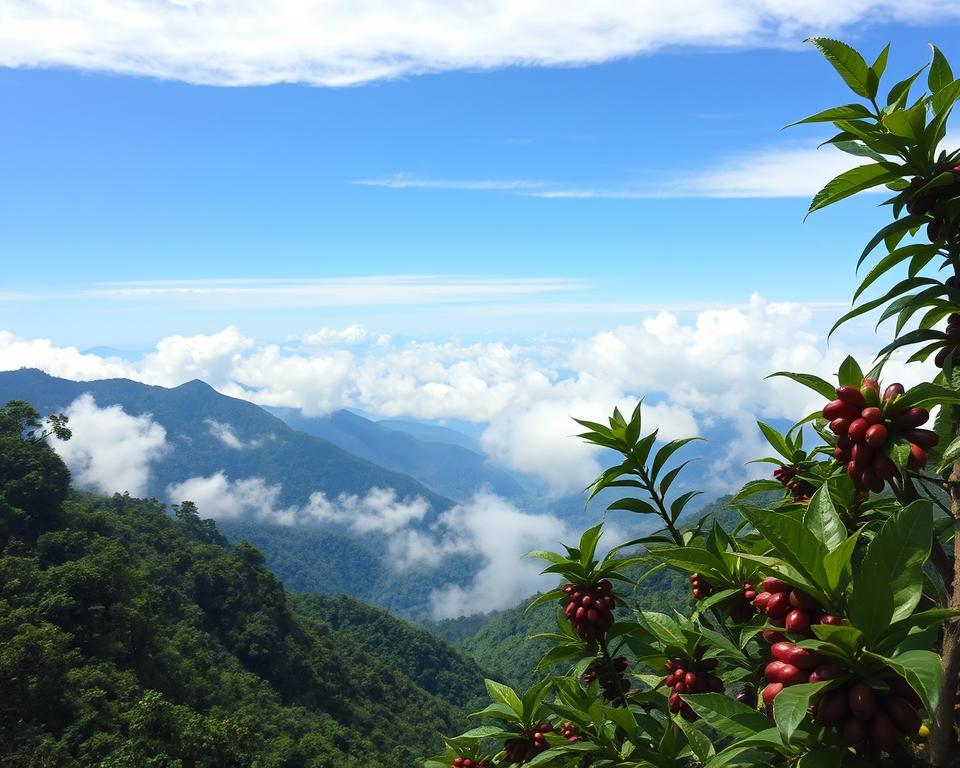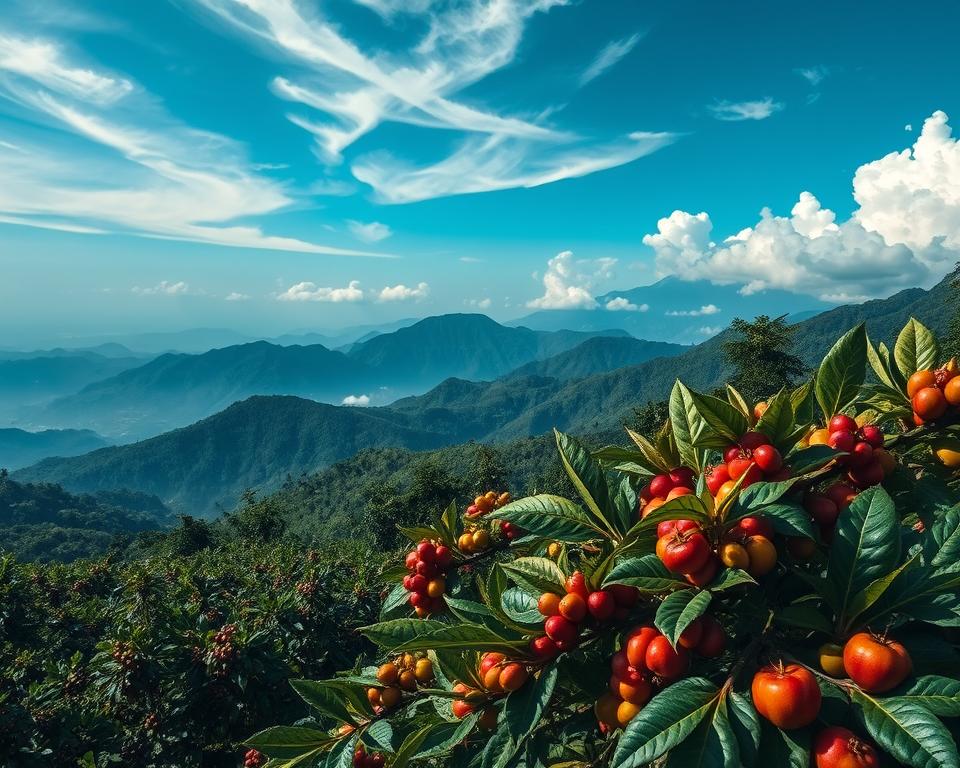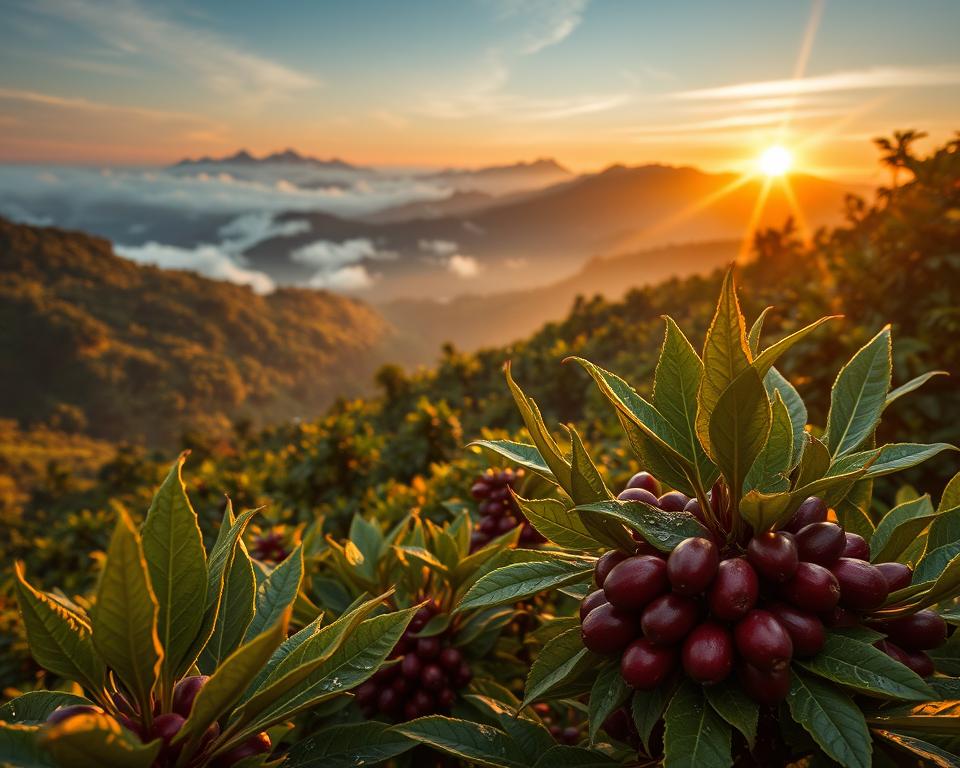High-altitude coffee means beans are grown way up high, from 1,000 to 8,000 feet. At these heights, quality coffee with great traits is produced. Cooler temperatures and less oxygen make coffee cherries ripen slower. This leads to beans that are more flavorful and complex.
Let’s look at Boyer’s Coffee in Denver, roasted at 5,400 feet. At this height, roasting is impacted by lower pressure and less oxygen. This process enhances the coffee’s sweetness, brightness, and aroma. It also gives it a smooth finish. High-altitude coffee is loved for its top-notch quality and rich flavors, making every cup special.
Why Elevation Matters for Coffee Cultivation
High-altitude cultivation is key for producing top-notch coffee beans. Elevation impacts climate and microclimates, affecting coffee’s growth. Let’s explore why elevation is so crucial.
Climate Impact
Coffee grown at higher altitudes, between 2,000 to 6,500 feet, experiences different climates. These areas have cooler temperatures, from 73-82 °F, and see less humidity with more sunlight. This environment slows coffee cherry ripening.
Slow ripening leads to denser beans with richer flavors. Arabica coffee, in particular, benefits from high elevations. It needs 60-80 inches of rain a year to thrive.
Microclimates and Flavor Development
High-altitude farms have unique microclimates. These vary even in small areas. They play a big role in how coffee flavors develop. For example, Cusco, Peru, at about 2,000 meters high, offers coffee with bright acidity and rich aromas.
Colombia’s specialty coffees, grown between 1,200 and 2,300 meters, boast a range of flavors. From floral and fruity to balanced acidity and medium body, thanks to their microclimates. These conditions are perfect for growing premium coffee, leading to better tasting cups.

High-altitude cultivation, like in Colombia’s steep slopes or Peru’s rich lands, creates the best conditions for premium coffee. It gives coffee unique and sought-after flavor profiles. Knowing about elevation and its effect on microclimates can make you enjoy each cup of coffee even more.
How Altitude Influences Coffee Flavor
The way altitude affects coffee flavor is quite intriguing. Above 4,500 feet, like in Ethiopian Yirgacheffe and Costa Rican areas, the cooler temperatures and less oxygen play a big role. This makes coffee cherries mature more slowly. This slow growth is key for complex flavors and scents to develop.

Slow Ripening Process
At high altitudes, coffee cherries take their time to ripen, usually in cooler weather between 60-70°F. This lets the beans naturally develop more sugars over time. The rich volcanic soil and lots of rain help too. This combination makes the beans have a bright acidity and unique flavors, which is what sets high-altitude coffees apart.
Complex Flavor Profiles
High-altitude conditions greatly enhance coffee’s flavor complexity. The beans grow slowly, leading to higher acidity and bold, lively flavors. Coffee grown above 3,000 feet is known for its sweetness, floral notes, and rich sugars, offering a layered taste experience. It’s this mix of flavors and scents that makes coffees from places like Kona and Tarrazú stand out to coffee lovers.
Interested in more about how altitude impacts taste? Look into my ideas on coffee and heart health. Knowing how altitude influences coffee can make each cup more meaningful.
High-Altitude Coffee Quality vs. Low-Altitude Coffee Quality
As a coffee aficionado, I often think about the differences between high and low-altitude coffee beans. The altitude at which coffee grows greatly affects its quality. To understand this, let’s look at why high-altitude beans are better, according to a coffee quality comparison.
Bean Density and Texture
High-altitude coffee has denser beans. The cooler temperatures and less oxygen make the cherries ripen slowly. This slow growth lets the beans get more nutrients. As a result, these beans are firmer and packed with compounds that enhance flavor.
Low-altitude coffee beans, however, grow quickly due to the warmth and sunlight. Their rapid growth leads to beans that are less dense and have a milder flavor. For instance, coffee from places like Bouma tries for quality but cannot match the depth of higher elevation beans.
Flavor Intensity
High-altitude coffee beans stand out for their intense flavors. Grown in places like Brazil and Ethiopia, they benefit from longer growth times. This allows them to develop complex sugars and aromas, making for a richer, more complex coffee.
On the other hand, low-altitude beans tend to have a quieter taste. They lack the bright acidity and strong flavors of high-altitude beans. Even though low-altitude regions try to improve, the difference in altitude crucially affects bean density and flavor. That’s why high-altitude coffee is often preferred by enthusiasts.
- Arabica beans make up about 60-70% of the world’s coffee production, highlighting their importance.
- Central America is seeing more climate changes, affecting their crucial Arabica coffee crops.
- A study has found that coffee from lower altitudes doesn’t have as good sensory qualities.
The Science Behind High-Altitude Coffee Roasting
High-altitude coffee roasting combines art and science. It brings out the best in coffee flavors. Roasting at places like Denver’s Boyer’s Coffee, which is about 5,400 feet above sea level, uses special atmospheric conditions. This results in a refined and flavorful cup of coffee.
Roasting at Lower Temperatures
At high altitudes, there’s less oxygen and lower pressure. This results in roasting at lower temperatures. For example, water boils at only 196 degrees Fahrenheit up high. This affects how hot we roast the coffee.
This leads to roasting for a shorter time. It’s a big part of the science behind it. The benefits? A controlled process that avoids burn and keeps the bean whole.
Preservation of Essential Compounds
High-altitude roasting is great for keeping the coffee’s flavors. Coffee has over 1000 chemical compounds. Keeping these compounds intact boosts sweetness, acidity, and body. This method makes the coffee sweeter, brighter, and smoothly velvety. It becomes more aromatic and tastier thanks to the unique high-altitude conditions.
Notable High-Altitude Coffee Regions
Exploring high-altitude coffee regions reveals unique and exceptional flavors. These areas are known for their special regional coffee profiles. They produce top-quality beans from the Hawaiian islands to Ethiopia and Costa Rica.
Hawaiian Kona Coffee
The Big Island of Hawaii is famous for its Kona coffee. It grows on the lush slopes of Hualalai and Mauna Loa. The elevations here go up to 2,000 feet.
This geography, paired with volcanic soil and perfect climate, gives Kona coffee a unique taste. This creates a smooth, rich coffee with hints of nutty and spicy notes.
Costa Rican and Ethiopian Beans
The Costa Rican beans and Ethiopian coffee are key when talking about high-altitude coffee. In Costa Rica, coffee grows between 4,500 to 6,000 feet in volcanic soils. This gives the beans a dense body with fruity and caramel flavors.
Similarly, Ethiopia, where coffee originated, is known for its esteemed beans. Ethiopian coffee grows at similar altitudes. It is famous for its bright acidity and complex flavors. The climate and unique processing bring out floral and fruity tastes.
These regions show how high-altitude farming, along with the right environmental factors, affects the coffee’s flavor and quality.
High-Altitude Coffee Benefits
High-altitude beans offer unmatched benefits for coffee lovers. Grown between 1000 and 2300 meters high, they come with unique flavors. In Denver, CO, Boyer’s Coffee roasts at about 5,400 feet. This high elevation plays a huge part in both the taste and health perks of the coffee.
At these heights, coffee is loaded with antioxidants. Thanks to cooler temps and a slow ripening process, the beans get extra tasty and nutritious. Also, water boils at a lower temp up here, which keeps the nutrients intact during roasting.
Besides great taste, high-altitude beans are also denser. This is due to the thin air up high. Such beans blend sweetness, brightness, and a smooth finish beautifully. Colombia’s coffees, grown high up, are perfect examples. They’re praised for their vivid acidity and complex tastes.
Rich soils and good water drainage in high places also boost bean flavors. This careful cultivation ensures every cup is rich in flavor and health benefits. High-altitude coffee truly stands out in a coffee lover’s daily routine.
Want to dive deeper into coffee’s quality and health aspects? Check out this link.
Can Choosing Rare Coffee Beans Enhance the Benefits of High-Altitude Coffee?
Choosing rare coffee beans can significantly enhance the experience of sipping high-altitude coffee. With their unique flavors and aromatic profiles, a rare coffee selection allows coffee lovers to explore the rich diversity that high altitudes offer. This combination not only elevates taste but also maximizes the health benefits associated with premium coffee.
Conclusion
As we wrap up our journey into high-altitude coffee, it’s clear that elevation shapes the coffee’s quality and taste. The different climates of Costa Rica give us coffee with unique flavors. The volcanic soil of Nariño, for example, makes the coffee sweeter and more acidic. Elevation truly does enhance coffee beans.
I’ve discovered that higher elevations result in denser beans with more complex flavors. For example, Tarrazu coffee has low acidity and hints of chocolate. Tres Rios coffee has a heavy body, mild acidity, and herbal notes. Central Valley beans stand out with their bright acidity, fruity notes, and sweet finish. These differences make choosing coffee exciting and enrich the taste for coffee lovers.
Choosing high-altitude coffee brings richer and deeper flavors. It involves learning about scientific roasting and cultivation in places like Hawaii, Costa Rica, and Ethiopia. Elevation greatly improves our coffee enjoyment. For coffee enthusiasts, high-altitude coffee offers a top-quality cup with unparalleled flavor.
FAQ
What are the benefits of high-altitude coffee beans?
High-altitude coffee beans have a complex taste and better quality. They stand out for their brightness, sweetness, and rich flavors. The conditions at high altitudes enhance these coffee characteristics.
Why does elevation matter for coffee cultivation?
Elevation creates unique climates that influence coffee growth. These climates affect bean density and taste, making premium coffees. Cooler temperatures, less humidity, and more sunlight at high altitudes improve coffee quality.
How does altitude influence the flavor of coffee?
High-altitude beans ripen slowly due to cooler conditions. This slow ripening develops complex flavors. As a result, coffee has a rich taste with aromatic nuances.
What is the difference between high-altitude and low-altitude coffee quality?
High-altitude beans are denser and more flavorful, thanks to cooler temperatures and less oxygen. They have more nutrients and mature well. On the other hand, low-altitude beans ripen too fast. They are less dense, resulting in simpler tastes.
What is the science behind high-altitude coffee roasting?
Roasting at high altitudes uses lower temperatures and shorter times. This is because there’s less pressure and oxygen. It helps keep the coffee’s natural flavors, like its sweetness and body.
Which regions are known for high-altitude coffee?
Famous high-altitude coffee areas include Hawaii’s Kona coffee region, Costa Rica, and Ethiopia. They produce exceptional beans with unique flavors specific to their high-altitude terrains.
What are the benefits of high-altitude coffee?
High-altitude coffee not only tastes great but also offers health perks. It’s rich in antioxidants and has well-preserved chemicals. The careful growing process and clean environment at high altitudes ensure top-quality coffee.




